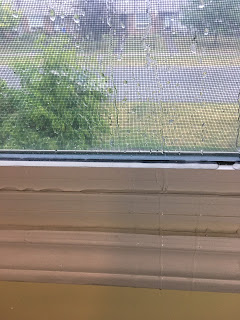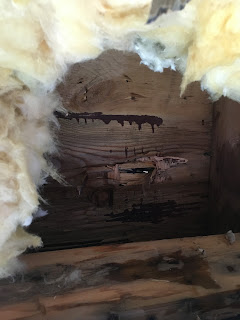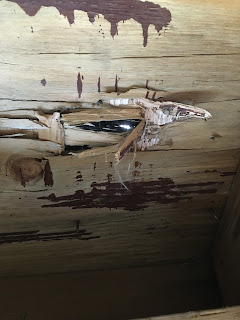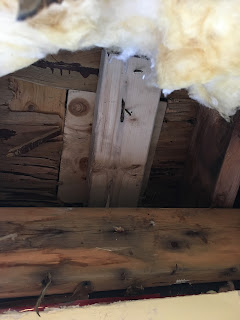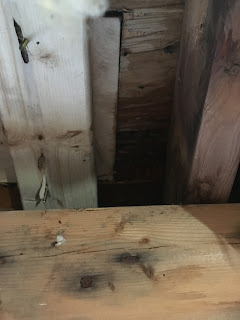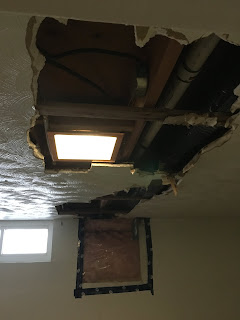Dislcaimer
I'm only on the fourth book: The Goblet of Fire. Something could come up later that throws the rest of this post out the window.
I did start reading them a while ago, and got further (the fourth book, I think), but I read through them faster, basically racing through them. I'm now reading them at a slower, more enjoyable pace.
Background
This post is an extension of my previous post: My Harry Potter Fan Theory where I ultimately conclude that in the Harry Potter universe, magic isn't magic per se; it's technology.
I have recently started reading the Harry Potter series of books, and am so far enjoying them.
When the books first came out, there was discussion amongst Christians as to what the Christian perspective on them was. The books easily lend themselves to comparison to Lord of the Rings and Narnia. There seems to be a "completeness" about 3. We seem to want triologies. So many jokes involve three similar, but contrasting things. (A priest, a pastor, and a rabbi walk into a bar...)
Tolkien and Lewis make two. They were both Brits who wrote fantasy highly popular, other-world epics, which are often enjoyed by younger readers, which have thus far stood the test of time. Where's the third?
Enter J.K. Rowling and Harry Potter. We don't know if Harry Potter will stand the test of time, but the other criteria are met.
But, for the Christian reader, Narnia is blatant allegory. Middle Earth mythology are not allegory, but are laced with Christian themes, and clearly from a Christian world-view. What about the Harry Potter universe?
Most Christian parents would be happy for their kids to read Narnia. For Middle Earth writings, it would be more a question of age-appropriateness. We read The Hobbit as a class in grade 4 (9 years old), and I just loved it! That summer I tried reading Lord of the Rings, and I just couldn't get past the birthday party! Now that I'm older and more used to longer, slower stories, Lord of the Rings is a much more enjoyable read.
But what about Harry Potter? Some would say "No way. That's witchcraft and it's of the devil!"
What I Heard Others Saying
When this discussion first came to my consciousness, I was still a post-secondary student living in Sault Ste. Marie. The default position was "Harry Potter promotes witchcraft, and is therefore evil."
So, at first I just went with the default position. I was too busy with school to be doing all that reading, and it's easy saving money on a movie ticket when none of your friends want to see the movie.
A friend, whom I greatly respect, disagreed with the default position.
"But, what about the spells? They use spells! Surely that's evil." I asked.
She replied to the effect that the Harry Potter spells are mostly just Latin, and that "nobody had a problem with 'Bippity-Boppity-Boo.'"
Then years later, on Twitter (I'm not calling it X) Tim Keller, in an AMA said that he enjoyed Harry Potter "as a story of friendship and redemption" or something to that effect.
Okay, if you're going to argue with Tim Keller on whether or not a Christian should partake, you'd better have some solid ammo.
Time for my own reading. I picked up a box set of the Harry Potter books, and started reading. And I noticed a few things that lead me to develop my own fan theory, which I will delve into now.
My Own Findings
First, in order to decide if Harry Potter is evil by Christian standards, we need to understand the basis for why we think witchcraft and wizardy is evil.
In Mere Christianity, C.S. Lewis says that the reason we don't have witch hunts anymore is that not that we don't think that witches are evil, but because we don't believe in witches anymore.
“Three hundred years ago people in England were putting witches to death. Was that what you call the 'Rule of Human Nature or Right Conduct?’ But surely the reason we do not execute witches is that we do not believe there are such things. If we did—if we really thought that there were people going about who had sold themselves to the devil and received supernatural powers from him in return and were using these powers to kill their neighbours or drive them mad or bring bad weather—surely we would all agree that if anyone deserved the death penalty, then these filthy quislings did? There is no difference of moral principle here: the difference is simply about matter of fact. It may be a great advance in knowledge not to believe in witches: there is no moral advance in not executing them when you do not think they are there. You would not call a man humane for ceasing to set mousetraps if he did so because he believed there were no mice in the house.”
― C.S. Lewis, Mere Christianity
So, the primary issues with witches are:
- They do evil things (ex: kill neighbours, destroy crops, etc.)
- They call upon evil beings (ex: the devil, demons, etc) for them to use their power
I'll look at each in turn.
Witches Do Evil Things
Yes, they do do evil things, especially "he who must not be named".
But they also do good things.
In the Harry Potter universe, magical powers seem to be like any technology; it can be used for good or evil. In The Philosopher's Stone, Snape talks about curing poison. Surely that's good.
Are you using your smartphone for good or for evil? Or are you just using it to facilitate whatever else you're doing (communication, research, entertainment, education, etc.)?
Furthermore, Dumbledore does talk about sin with the assumption that sin is something bad. "Curiosity is not a sin", or something like that.
The Harry Potter universe acknowledges good and evil, and their versions of good things and evil things seem to be pretty much in line with Judeo-Christian versions. Curing poison is good. Killing people is bad.
Witches Call Upon Evil Beings
Here's where things get interesting.
There's no mention of any specific supernatural being (that I've gotten to). But in my reading I noticed a couple of things: First, they celebrate Halloween (aka: All Hallows (ie: Saints) Eve), not Samhain. They celebrate Christmas, not Winter Solstice. That is to say: they're celebrating Christian holidays instead of the actual pagan holidays! (It gets a little tricky with Easter because the word Easter is pagan in origin, not Christian.)
If the Harry Potter universe were truly trying to indoctinate kids into the occult, why not introduce them to Samhain and Winter Solstice? Rowling is already introducing everyone to a world of new vocabulary (like Muggle and Squib), a whole new sport with complex rules, new magical creatures, a history, etc. Introducing the audience to Samhain and Winter Solstice would have been small potatoes compared to the rules of Quiddich.
To me, that was the first thing I noticed that suggested that my friend and Tim Keller might be right; these aren't manuals of witchcraft the way we think of witchcraft.
So, where do they get their power?
I explore this further in My Harry Potter Fan Theory. In summary, they're not witches and wizzards in the Harry Potter world; they're more like X-Men. They have a genetic mutation (or several) that allow them, through the use of a wand and incantations, to manipulate the electromagnetic field. It's not magic. It's technology that's not understood through the lens of scientific method.
And that doesn't make a thing evil. Simply using a power that you don't understand doesn't mean you're grasping at power that you shouldn't. Do you understand how your phone works? I don't. And we still use our phones.
Aren't They Using Power For Their Own Ends?
This is a common objection from Christians about Harry Potter. If I understand it, the object could be summed up as follows: "In Narnia and Middle-Earth, power is to be used for the betterment of others, not achieving one's own objectives, like it is in Harry Potter. Those witches and wizards are using magic for their own means, rather than for others'."
But is that what's going on? Let's look into it.
Power in Narnia and Middle Earth
Narnia
There are a few instances where people are put in positions of power, and saying they do not feel ready, and Aslan assures them that it's that feeling that says that they are ready, and if they had said they were ready, they wouldn't be. And, of course, The White Witch would like to rule Narnia and prevent the four humans from ruling; and Edmond would like to be at her side bossing Peter around and putting him in his place, all while he eats Turkish Delight. Then there's the Last Battle, where ape tries to basically take over by being the puppet master who controls "Aslan". And the green witch in The Silver Chair.
So, yes, there do seem to be themes of the dangers of the pursuit of ill-gotten power and authority. All true authority and power belongs to Aslan. And, yes, any unrightful power is often self-serving, rather than others-serving. It seems to be a theme that a king or queen's primary duty is to their own people; servant leadership.
But, how apparent would this be to Lewis' target audience: 7 to 9 year olds? I don't think it's the main point of the books. It seems more secondary.
Middle Earth
(Forgive me if I conflate the movies with the books.)
In Middle Earth, the pursuit of power is largely a Sauron thing. (A whole series of posts could be written on these themes in Middle Earth from before the end of the Third Age, which is when The Hobbit and Lord of the Rings take place. And most people are only familiar with those writings, so I'll stick to them here.)
Sauron wants to take over, so he created the rings of power (minus The Three). This would help him take over the world. I don't think it's ever stated what his end-game was. Was it to take over, then bring Melkor back to Middle Earth to finally rule? Or just to rule himself? Then what?
Gandalf and Galadriel are both offered The One Ring, and decline, but not without saying they would start off with the best of intentions, but would eventually go bad, serving themselves. Same thing would happen with men.
The special thing about hobbits is that they have enough interest to keep the ring around without succumbing to it for long enough to return it and destroy it. Others would likely go bad before reaching the mountains bordering Mordor. Whereas Tom Bombadill, who's so self-sufficient, wouldn't even care about the ring, and would likely lose it.
I think Tolkien's warning about the pursuit of power could be summed up as following: "You may start out like Superman, but eventually you would turn into Homelander."
It seems like the pursuit of power is a substantial theme in Lord of the Rings. Power must be kept in check. No one should have absolute power.
In other words, Tolkien isn't trying to say "Power is to be used for others, not for the self." He's trying to say "The pursuit of power is a problem."
Power in Harry Potter
Lewis and Tolkien warn us against the perils of power. It's more subtle, but Rowling warns us of the same thing! Remember, in the Harry Potter universe is that magic is not the power like, say, the one ring. Magic is not the power. It's a talent based in genetics.
It's like if you found out you had perfect pitch as a kid, you should sign up for music lessons; you need to hone that skill to be useful; to be a gift to the world, to fulfill your God-given purpose. When Happy Gilmour finds out he's better at golf than hockey, he develops the skill of golf to win enough money to buy his grandma's house back (or whatever it was for).
If you had the "magic gene" that exists in the Harry Potter universe, you need to learn to control it. (In Fantastic Beasts we see what happens when magic is suppressed. It's not good.) You don't go to Hogwarts to learn to summon satanic powers, or communicate with the under-world. It's closer to taking music lessons when you find out you have perfect pitch.
And, really, what do they use these spells for? They're not destroying crops or killing babies. They're using it the way we use technology. We have cars and airplanes. They have broomsticks and portkeys. We have phones. They have owls and some can communicate through fires. We have microphones and PA systems. They can amplify their voices with wands. We have flashlights. They can create light with their wands. They do hunt vampires (implying that vampires are inherently evil), or train dragons, or keep magical creatures out of view of muggles. It seems like they're just going about their lives as we are, just differently. If the existence or use of "magic" is evil, then so is any of our technology.
In fact, there's a whole government body overseeing the use of magic, making sure everything is done properly, and people aren't abusing their magic.
The "magic" isn't the power. But power still exists in the magic world as it does in our world, Narnia, or Middle Earth. It's the domination of other people. It's ill-gotten authority. And the Harry Potter books and movies have plenty of warning against that; just like Lord of the Rings, or the Chronicles of Narnia. So, don't take a throne that doesn't belong to you; don't use the One Ring to fight against Mordor. And don't use any spells to dominate or kill others.
The warning is in the four houses: Gryffindor, Hufflepuff, Ravenclaw, and Slytherin. As Hagrid (inaccurately) points out "There's not a witch or wizard that went bad that wasn't in Slytherin." But, he's correct in most instances. Part of the traits of students in House Slytherin are they desire power and cunning and ambition. They want to get on top. They want to be better than others. (Not all, but some.)
Slytherin exists as a warning to us what happens when those traits (which, as C.S. Lewis points out, are not evil in and of themselves) get out of hand and take over as the top thing. There's a whole 43 minute video on YouTube exploring Why does Slytherin still exist?. I didn't watch the full thing (it seems like there may be spoilers), but it seems like we don't know of any good Slytherins. There probably are good Slytherins, but their stories are probably not interesting enough to make it into the stories. (I understand there may be some repentance later on in the stories. But no spoilers, please.)
And it's clear that your personal preferences play a role in what house you're placed in. Harry could have gone Slytherin, but he wanted Gryffindor, and there he was placed. It's as though Rowling is warning us: "Don't desire Slytherin. It's better to desire friendship, loyalty, bravery, knowledge than power."
The Imperius Curse
Furthermore, it can be said that the real problem with the power is to dominate or control other people. Ultimately, that's what the One Ring gives you. The Green Witch from The Silver Chair is in the wrong for doing this.
And in Harry Potter, the Imperius Curse allows someone to do just that! "Ah ha! See! EVIL!"
Except that the Imperius Curse is one of the three "unforgivable curses" which lands one a life sentence in Azkaban without possibility of parole.
So it seems that Harry Potter is teaching us that there is right and wrong; and it's wrong to control other people for your own ends. Just like in Middle Earth and Narnia.
Divination
But what about Divination? That's clearly frowned upon in the Bible, and that's in Harry Potter.
Rodney Dangerfield gets more respect than Divination does in the HP universe. They downright make fun of it, often saying or implying that it's not a real thing.
Conclusion
"Power" or "magic" in the Harry Potter world is derived from genes, and not evil spirits, demons, or the devil. We're "fearfully and wonderfully made." (Psalm 139:14) If some people have the genetic ability to interface with the world in a different way than others, then it's God that gave them that gift. Magic people in the Harry Potter universe aren't getting their power from Satan. The source of the magic is not in conflict with a Christian world and life view.
Any technology can be used for good or evil. Harry Potter uses technology and genes to do mostly good.
Since the two problems with witchcraft (source of power, uses of power) are inconsistent with the Harry Potter universe, we can conclude that there's nothing inherently wrong with Christians enjoying the writings or the movies.
Lastly....
I will continue to update this post as I read through the books and find further supporting, or contradictory evidence.
“Fairy tales do not tell children the dragons exist. Children already know that dragons exist. Fairy tales tell children the dragons can be killed.”
― G.K. Chesterton


